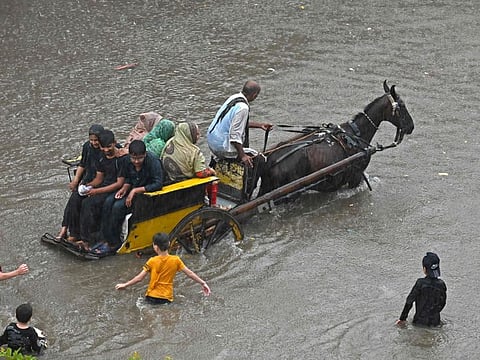Pakistan: Record-breaking rains in Lahore claim 11 lives, cause urban flooding
Lahore experienced two intense spells of torrential rain and a powerful 90km windstorm

Islamabad: Heavy monsoon rains lashed Pakistan’s Punjab province, killing at least 11 people and flooding roads in Lahore city.
The incessant monsoon rains shattered a 30-year-old rain record in Lahore, according to local officials.
Lahore Commissioner Mohammad Ali Randhawa stated that “291mm of rain in a 10-hour period shattered a 30-year record in the city”.
He also mentioned that over 200mm of rain was recorded in more than a dozen areas across Lahore. The commissioner’s office has instructed local departments to expedite the drainage process.
However, the Met Office contested the claim made by the commissioner and Water and Sanitation Agency (Wasa) that Lahore had not experienced such heavy rainfall in 30 years.
In its official release on July 6, the Met Office stated that Lahore’s Lakshmi Chowk neighborhood received the highest recorded rainfall of 150mm on July 5.
Urban flooding in Lahore
Lahore, known as Pakistan’s cultural capital, experienced two intense spells of torrential rain and a powerful 90-kilometre windstorm on Wednesday.
These weather conditions led to significant flooding in various neighborhoods, causing around 35 per cent of the city to lose access to essential utilities such as electricity and water supply. The heavy downpour also resulted in chaotic traffic throughout the day, with roads submerged in water. Even Canal Road, considered one of the well-maintained routes in the city, flooded due to an overflowing canal, affecting multiple neighborhoods along its path.
Punjab’s caretaker Chief Minister, Mohsin Naqvi, said that the “record-breaking rains” caused urban flooding and assured the public that the situation was being monitored. He also stated that the Punjab administration was making all efforts to clear the water. Meanwhile, the Lahore Electricity Supply Company (LESCO) reported power outages in several areas due to continuous rainfall, saying the restoration process would begin once the rain subsides.
13 lives lost
During the two days of rain on July 5 and 6, at least 13 people lost their lives in weather-related incidents in Lahore and other regions of Punjab. The heavy rainfall on Thursday led to tragic incidents, resulting in the deaths of four individuals and injuries to 15 others. Local media reports mentioned an incident in the Amar Sidhu area where a roof collapse claimed the lives of four people, including three children under the age of 10. Additionally, nine lives were lost in various incidents across Punjab province on July 5, including cases of electrocution, roof collapses, drowning, and lightning strikes.
Authorities on alert
On Thursday, the National Disaster Management Authority (NDMA) of Pakistan held a Flood Management Conference in Islamabad to address the potential threat of floods from eastern rivers and nullahs (streams).
The conference included key stakeholders such as Punjab Provincial Disaster Management Authority (PDMA), Pakistan Meteorological Department (PMD), Indus River System Authority (IRSA), Rescue 1122, Pakistan Army and others. Chairman NDMA Lt. General Inam Haider Malik stressed the importance of preparedness and instructed authorities to conduct a national simulation exercise to improve readiness in dealing with flood-related challenges.
PMD provided a comprehensive briefing on real-time data monitoring of eastern rivers, cautioning that “8-10 July would be a critical period for upper catchment areas of Rivers Sutlej, Ravi, Chenab, and partially Jhelum.” The public was advised to stay informed and follow guidance from local authorities during monsoon and rain emergencies.
Met Office forecast
The PMD had forecasted monsoon rains from July 3 to 8 and raised concerns about urban flooding, urging local authorities to remain on high alert. Pakistan’s capital city, Islamabad, also experienced heavy rainfall this week.
The Met Office has issued warnings about urban flooding in low-lying areas of Islamabad, Rawalpindi, Attock, Gujranwala, Lahore, Sialkot, Sahiwal, Multan, Bahawalpur, Kohat, Peshawar, and Bannu during the expected rainfall period from July 6 to 8.
The department has also cautioned that the rains “may trigger landslides in vulnerable areas such as Murree, Galliyat, Kashmir, Gilgit Baltistan, and hilly regions of Khyber Pakhtunkhwa” from July 6 to 8.
Last year, Pakistan witnessed unprecedented rains and floods that killed 1,700 people, affected 33 million people, and submerged one-third of the country under water. The floods also caused $30 billion in losses.
Sign up for the Daily Briefing
Get the latest news and updates straight to your inbox



